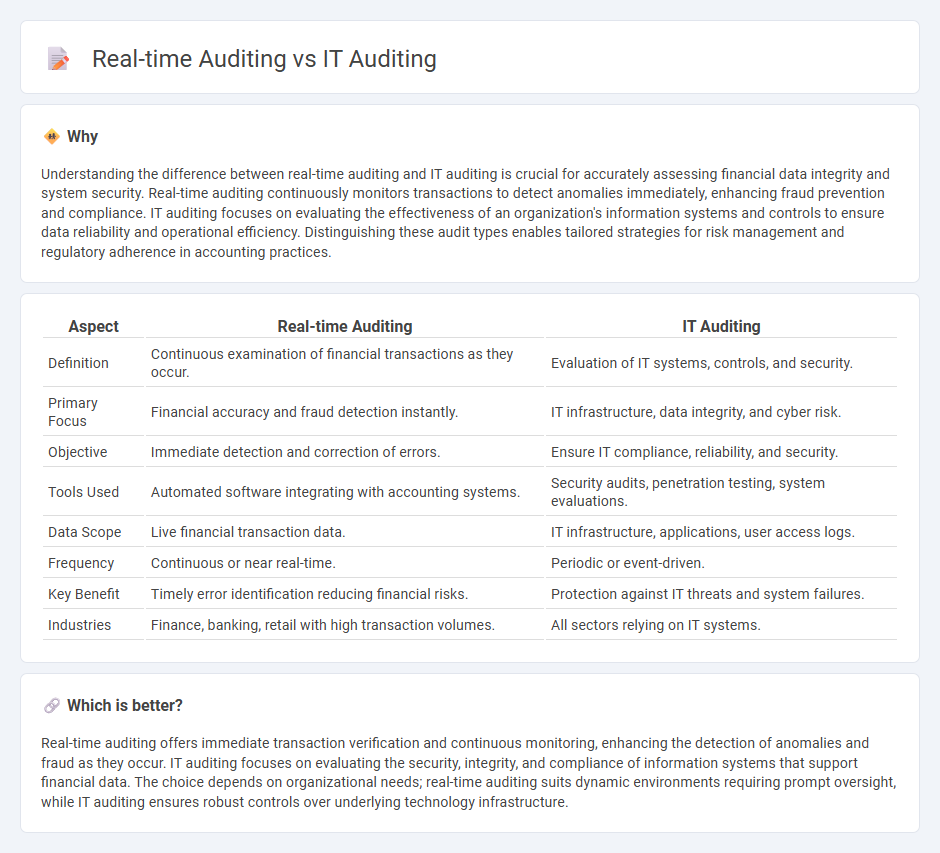
Real-time auditing leverages continuous data monitoring to detect anomalies and ensure compliance instantly, enhancing financial transparency and decision-making accuracy. IT auditing evaluates the effectiveness and security of information systems, focusing on data integrity, cybersecurity risks, and regulatory adherence within digital infrastructures. Explore the distinctions and benefits of real-time auditing versus IT auditing to optimize your organization's audit strategy.
Why it is important
Understanding the difference between real-time auditing and IT auditing is crucial for accurately assessing financial data integrity and system security. Real-time auditing continuously monitors transactions to detect anomalies immediately, enhancing fraud prevention and compliance. IT auditing focuses on evaluating the effectiveness of an organization's information systems and controls to ensure data reliability and operational efficiency. Distinguishing these audit types enables tailored strategies for risk management and regulatory adherence in accounting practices.
Comparison Table
| Aspect | Real-time Auditing | IT Auditing |
|---|---|---|
| Definition | Continuous examination of financial transactions as they occur. | Evaluation of IT systems, controls, and security. |
| Primary Focus | Financial accuracy and fraud detection instantly. | IT infrastructure, data integrity, and cyber risk. |
| Objective | Immediate detection and correction of errors. | Ensure IT compliance, reliability, and security. |
| Tools Used | Automated software integrating with accounting systems. | Security audits, penetration testing, system evaluations. |
| Data Scope | Live financial transaction data. | IT infrastructure, applications, user access logs. |
| Frequency | Continuous or near real-time. | Periodic or event-driven. |
| Key Benefit | Timely error identification reducing financial risks. | Protection against IT threats and system failures. |
| Industries | Finance, banking, retail with high transaction volumes. | All sectors relying on IT systems. |
Which is better?
Real-time auditing offers immediate transaction verification and continuous monitoring, enhancing the detection of anomalies and fraud as they occur. IT auditing focuses on evaluating the security, integrity, and compliance of information systems that support financial data. The choice depends on organizational needs; real-time auditing suits dynamic environments requiring prompt oversight, while IT auditing ensures robust controls over underlying technology infrastructure.
Connection
Real-time auditing leverages continuous data analytics to monitor financial transactions instantaneously, enhancing the effectiveness of IT auditing by providing up-to-date insights into system controls and security. IT auditing assesses the technological infrastructure and cybersecurity measures that support financial data integrity, enabling real-time auditing to identify discrepancies and risks promptly. Integrating these audit approaches improves risk management, compliance, and the accuracy of financial reporting through advanced automated monitoring tools.
Key Terms
**IT auditing:**
IT auditing evaluates the security, efficiency, and compliance of an organization's information systems by reviewing IT infrastructure, policies, and controls to identify risks and vulnerabilities. It involves detailed assessments of system backups, access controls, and data integrity to ensure regulatory adherence and safeguard against cyber threats. Discover more about how IT auditing strengthens organizational resilience and supports risk management.
Information Systems Controls
IT auditing evaluates information systems controls through periodic assessments to ensure data integrity, confidentiality, and compliance with policies and regulations. Real-time auditing continuously monitors system activities using automated tools to detect anomalies and security breaches instantly. Explore further to understand how these approaches enhance organizational cybersecurity and operational resilience.
Data Integrity
IT auditing evaluates historical data and system controls to ensure compliance, accuracy, and security, emphasizing data integrity through periodic review of logs and transactions. Real-time auditing continuously monitors data flows and system activities, enabling immediate detection and correction of integrity issues using automated tools and analytics. Explore the benefits and applications of both auditing approaches to enhance your organization's data integrity strategies.
Source and External Links
What is IT audit (information technology audit)? - TechTarget - An IT audit examines and evaluates an organization's IT, operations, and controls to ensure data integrity, asset protection, regulatory compliance, and alignment with business goals.
The Ins and Outs of IT Audits - AuditBoard - IT audits focus heavily on cybersecurity, assessing access controls, network security measures, incident response, and ensuring confidentiality, integrity, availability, accountability, and auditability of IT systems.
Information technology audit - Wikipedia - IT audits evaluate management controls in IT infrastructure to ensure availability, confidentiality, and integrity of information systems, minimizing risks to the organization's valuable data assets.
 dowidth.com
dowidth.com